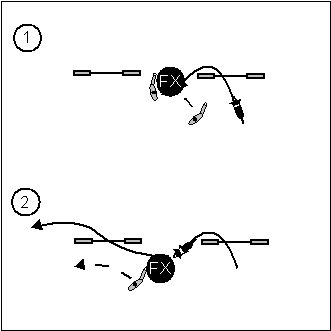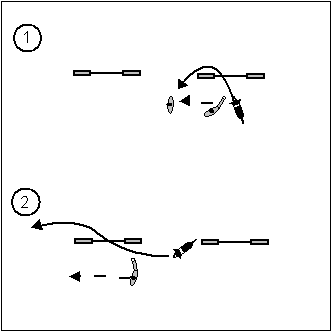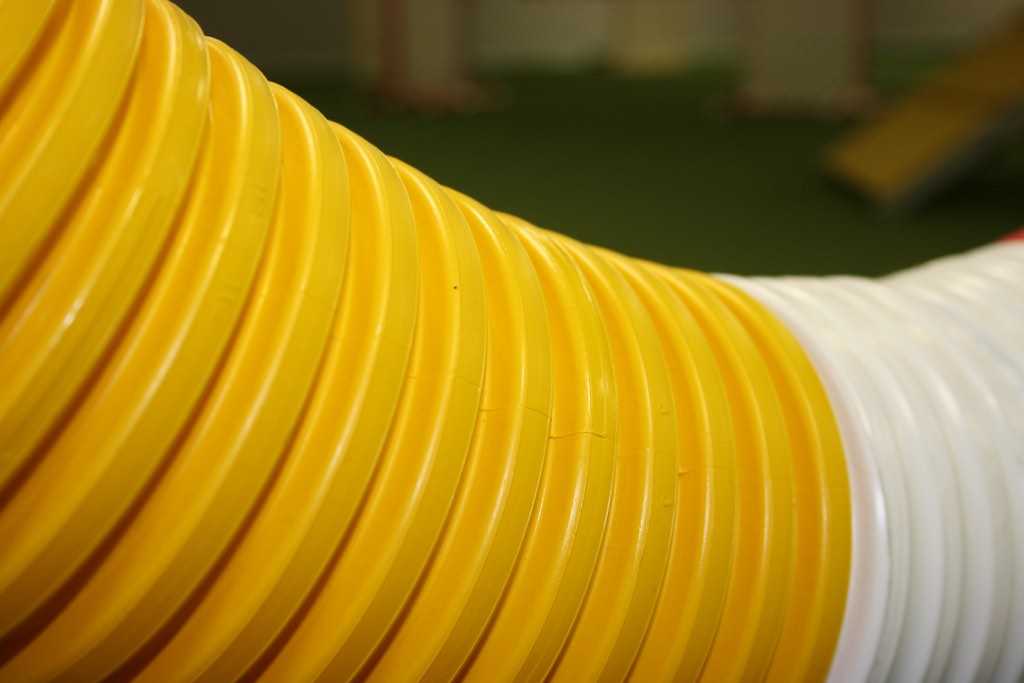Traditional Threadle Handling
12 Jan 2007
There are three “traditional” methods for handling Threadles. Two of which have the handler perform crosses and the third uses only pushing and pulling. This article presents descriptions, diagrams and video for each approach.
Front Crosses
One common method for handling Threadles is to Front Cross Learning the Front Cross - VideoFront Cross between the two jumps to turn the dog back toward the front of the second jump. Then Front Cross again to turn the dog back over the second jump. This could also be viewed as Reverse Flow Pivot handling. This is shown in the diagram below:
Front Cross - Front Cross Threadle Handling

I shot some video of Meeker and me giving this handling a whirl. I demonstrated with a three jump Threadle so you could see using this handling both from a static start (i.e. Lead Out) and in motion:
Front Cross - Post Turn and Front Cross - Post Turn - Rear Cross
It is also possible to Front Cross and then Post Turn and Push the dog over the jump while the handler remains on the landing side of the first jump. The handler then reaches back with their inside arm to call the dog back over the jump into the handler. Unlike the other two methods this handling puts the handler on the landing side of the jumps:
Front Cross - Post Turn Threadle Handling

This approach requires handler to really get moving during the Post Turn and get out of the dog’s way so the dog can land as they jump in toward the handler. Another permutation would be for the handler to wait after the Post Turn until the dog takes the second jump and then Rear Cross Learning the Rear CrossRear Cross on the landing side of the jump (but this puts the handler behind the dog which wouldn’t be desirable if there was another Threadle following this one).
Sorry no video for this one, I could only get Meeker through a two jump Threadle with this handling, not the three jump setup I wanted to demonstrate.
Push - Pull - Push Single Sided Handling
Handlers can also Push the dog over the jump and then Pull the dog back between the jumps and Push the dog over the last jump while the handler remains on the take off side of the jumps. This is very similar to Single Sided Serpentine Handling. In this case dropping the arm or shoulder nearest the dog means come in to me between these two jumps. In the Serpentine case it means come in to me after taking the jump. In a tightly spaced sequence this lack of clarity isn’t a good thing.
I’ve found this approach to be difficult because there are so many handler cues that are telling the dog to jump long over the first jump. Shoulders, hips, feet facing forward, and the handler’s motion is toward the second jump. The collecting cues are the handler position relative to the first jump and any verbal command given to the dog (i.e. “Step”, etc.), lastly the handler usually needs to slow or even stop to get the dog to come between the jumps; due to the forward motion cues. I find that my dogs often land setup to take the second jump from the back side and can’t easily make the turn between the jumps.
Push - Pull - Push Threadle Handling

Here is video of a tired Meeker and me giving this handling a whirl:
You’ll notice I’m pausing and waiting for Meeker to come between the jumps before moving forward and directing him to the next jump. A more practiced team wouldn’t need as much of a pause as we do.
Alternate Handling Approaches
Some handlers/trainers use a verbal “Step” or “Wrap” command as part of their Push - Pull - Push handling to cue their dog to short stride over the first jump and turn back into them before the send to the second jump. This additional verbal cue can help overcome the other forward cues they are giving the dog. Similarly, handlers/trainers who train an Over Come command could exploit that command in a similar way. So a Threadle becomes an “Over Come” followed by a “Go”.
An outcome of Linda Mecklenburg’s handling system is a very smart and smooth way of handling Threadles I call Single Sided Threadle Handling.
Conclusion
All of these methods can work but they require good handler and dog coordination, practice and, especially with a fast dog or tight jump spacing, excellent timing to be successful. But with practice they have worked well for many agility teams. Give these approaches a try and see what works best for your team.
If you enjoyed this article won't you please:  Thanks!
Thanks!
